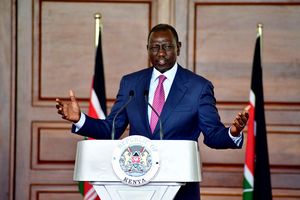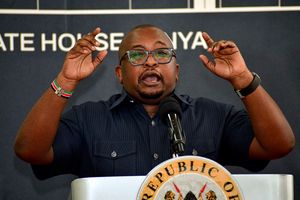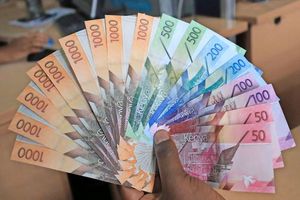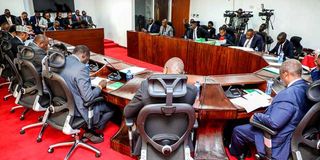
The National Assembly Departmental Committee on finance and National Planning chaired by Molo MP Francis Kuria Kimani during the session at the Bunge Tower Nairobi.
A parliamentary committee has flagged conflicting figures showing a variance of Sh73 billion in budget documents presented by the National Treasury for the 2025/2026 financial year.
In a spectacle that rekindles the infamous computer error debacle that marred the 2008 budget, the National Assembly committee on Finance and National Planning has demanded answers as to which of the two figures is the correct account of total government expenditures for the new financial year.
Documents presented by the National Treasury indicate Sh4.263 trillion as the anchor amount for the 2025/26 financial year but also refer to Sh4.336 trillion as overall expenditures, casting doubts about the Sh73 billion difference.
The National Treasury was appearing before the committee for consideration of the Budget Policy Statement (BPS) for the 2025/2026 financial year.
Committee chairman Kimani Kuria noted the anomaly and when he pressed the Treasury officials, he could not get an immediate answer over the gap.
“I have noted that there is a variance in the Budget Policy Statement from the Treasury. Which is which?” Mr Kuria asked about the conflicting figures.
However, senior Treasury officials led by Director-General, Accounting Services Benard Ndung’u could not provide an immediate answer. Instead they asked to be allowed to submit a harmonised document at a later date.
“Mr Chairman we will submit a document with the correct figures,” Mr Ndung’u replied.
Mr Kuria said there is no way a budget document can have two figures for the same baseline of operations.
“You cannot have different figures for the same budget. It cannot just happen,” Mr Kuria said.
“The Sh73 billion is way material that we should not just ignore. We need one figure,” Mr Kimani added.
By the time the MPs identified the variance, Treasury Principal Secretary Chris Kiptoo, who had appeared briefly at the committee, had already left. The PS excused himself informing MPs he was bereaved and was needed at Lee Funeral Home.
He left behind a team of senior Treasury officials who he said are competent to answer the MPs’ questions.
“Mr Chairman, I’m leaving you with a team of competent officials who are capable of tackling any question that may come up,” Dr Kiptoo said as he left the committee room.
It is then that Mr Ndung’u took over his seat surrounded by other senior officials from the ministry.
The committee members now want Treasury Cabinet Secretary John Mbadi and Dr Kiptoo to appear before them on Tuesday next week to provide clarity on the matter.
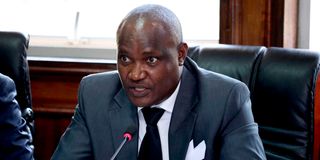
National Treasury and Economic Planning Cabinet Secretary John Mbadi.
The first expenditure figures given by the Treasury for the 2025/2026 budget have Sh4.263 trillion as the overall amount.
This includes recurrent expenditure of Sh3. 096 trillion, Sh725.1 as development expenditure, Sh436 billion for transfer to county governments and Sh5 billion as Contingency Fund.
The second expenditure figures in the Treasury documents cite an overall amount of Sh4.336 trillion. This includes Sh2.562 trillion allocation for the national government.
The amount is broken down into Sh2.493 trillion for the Executive, Parliament (Sh42.4 billion) and Sh25.7 billion for the Judiciary. The Consolidated Fund Services has Sh1.368 trillion and county government shareable revenue is Sh405 billion
The BPS is prepared in compliance with the provisions of the Public Finance Management Act, 2012.
It outlines the strategic priorities of the government, highlights the current state of the economy, provides macro-fiscal outlook over the medium term together with a summary of government spending plans.
The Constitution requires the National Treasury to table the document in Parliament by February 15 each year.
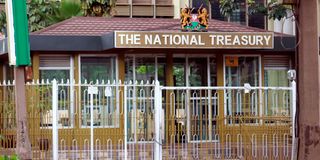
The National Treasury building in Nairobi.
The Budget Policy Statement sets out the broad strategic priorities and policy goals that will guide the national and county governments in preparing their budgets both for the following financial year and over the medium term.
The variance in the figures mirrors another spectacle the country witnessed during the 2008/2009 financial year under the tenure of then Finance minister Uhuru Kenyatta.
At the time, the Grand Coalition government’s budget had inflated figures that were uncovered by MPs.
Then Imenti Central MP Gitobu Imanyara tabled the discrepancies in the Supplementary Budget indicating that there was an extra Sh9.2 billion.
Mr Kenyatta attributed the discrepancy to a ‘computer error.’
“There may be figures that may not be 100 per cent correct as a result of computer inputs,” Mr Kenyatta sought to explain the curious situation.
He was quizzed by a joint committee of Finance and Budget over the ‘typing’ error. Mr Kenyatta would later be elected President in 2013 going on to serve for 10 years until 2022 when he was succeeded by Dr Ruto.
And in 2023, Controller of Budget Margaret Nyakang’o kicked up a storm after she went public with how National Treasury officials had over-budgeted her salary alongside that of other senior State officers, by up to three times, a fraud she said could have occasioned Sh1 billion loss of taxpayer’s money annually.
“When I was doing the budget for CFS, where I am paid from, I found out that my salary was budgeted at three times what I am paid. I am the only state officer in my institution and so there is nothing like confusion there. I asked… and have not received the answer to date,” Dr Nyakang’o said at the time.
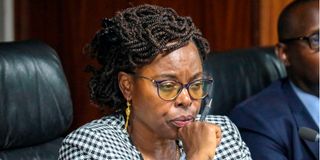
The Controller of Budget Margaret Nyakang'o.
In Thursday's committee session, Karachuonyo MP Adipo Okuome also asked about the specific measures that Treasury is putting in place to ensure that Kenyans don’t feel they are overtaxed.
“I see you want to broaden the tax base but I think you should be thinking of giving people a tax relief. You are overtaxing people,” Mr Okuome said.
“Nowadays, when you go to hotels and sit, there are no people coming to eat because they don’t have money,” Mr Okuome added.
In his presentation to the committee before he left, the PS told the committee that economic growth is expected to pick up to 5.3 per cent in 2025 and 2026 and retain the same momentum over the medium term which will be largely driven by enhanced agricultural productivity, a resilient services sector and ongoing implementation of a number priorities.
Dr Kiptoo told the lawmakers that in the financial year 2025/2026, the government will build on the solid foundation laid over the last two years in order to consolidate gains made under Bottom Up Economic Transformation Agenda (BETA).
The PS said the government has put in place various strategies which include a combination of tax administrative and tax policy reforms to shore up government revenue and reduce public debt.
These policies include expansion of the tax base, minimising tax expenditures, leveraging on technology to revolutionise tax processes, sealing revenue loopholes and enhancing the efficiency of the tax system.
Dr Kiptoo also told the committee that the government will focus on non-tax revenue that Ministries, Departments and Agencies (MDAs) can raise through the services they offer.
To strengthen expenditure control and improve effectiveness in public spending, Dr Kiptoo said the focus will be on the implementation of austerity measures aimed at reducing recurrent expenditure.

